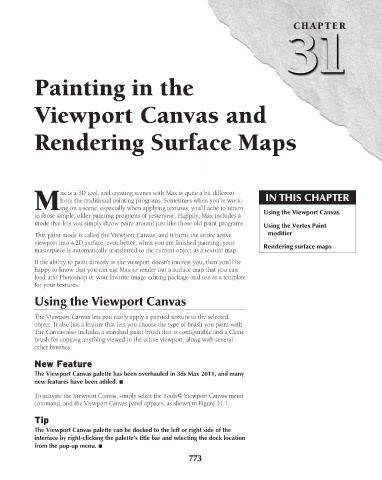Page 821 - Kitab3DsMax
P. 821
CHAPTER
Painting in the
Viewport Canvas and
Rendering Surface Maps
ax is a 3D tool, and creating scenes with Max is quite a bit different
from the traditional painting programs. Sometimes when you’re work- IN THIS CHAPTER
Ming on a scene, especially when applying textures, you’ll ache to return
to those simple, older painting programs of yesteryear. Happily, Max includes a Using the Viewport Canvas
mode that lets you simply throw paint around just like those old paint programs.
Using the Vertex Paint
This paint mode is called the Viewport Canvas, and it turns the entire active modifier
viewport into a 2D surface; even better, when you are finished painting, your
masterpiece is automatically transferred to the current object as a texture map. Rendering surface maps
If the ability to paint directly in the viewport doesn’t interest you, then you’ll be
happy to know that you can use Max to render out a surface map that you can
load into Photoshop or your favorite image-editing package and use as a template
for your textures.
Using the Viewport Canvas
The Viewport Canvas lets you easily apply a painted texture to the selected
object. It also has a feature that lets you choose the type of brush you paint with.
The Canvas also includes a standard paint brush that is configurable and a Clone
brush for copying anything viewed in the active viewport, along with several
other brushes.
New Feature
The Viewport Canvas palette has been overhauled in 3ds Max 2011, and many
new features have been added. n
To activate the Viewport Canvas, simply select the Tools ➪ Viewport Canvas menu
command, and the Viewport Canvas panel appears, as shown in Figure 31.1.
Tip
The Viewport Canvas palette can be docked to the left or right side of the
interface by right-clicking the palette’s title bar and selecting the dock location
from the pop-up menu. n
773

